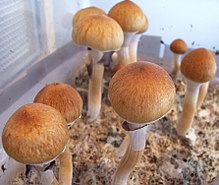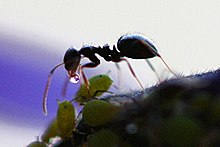
Some scholars have proposed that manna is cognate with the Egyptian term mennu, meaning "food".[13] At the turn of the twentieth century, Arabs of the Sinai Peninsula were selling resin from the tamarisk tree as man es-simma, roughly meaning "heavenly manna".[12] Tamarisk trees (particularly Tamarix gallica) were once comparatively extensive throughout the southern Sinai, and their resin is similar to wax, melts in the sun, is sweet and aromatic (like honey), and has a dirty-yellow color, fitting somewhat with the Biblical descriptions of manna.[14][15] However, this resin is mostly composed from sugar, so it would be unlikely to provide sufficient nutrition for a population to survive over long periods of time,[14] and it would be very difficult for it to have been compacted to become cakes.[15]
In the Biblical account, the name manna is said to derive from the question man hu, seemingly meaning "What is it?";[16] this is perhaps an Aramaic etymology, not a Hebrew one.[15] Man is possibly cognate with the Arabic term man, meaning plant lice, with man hu thus meaning "this is plant lice",[15] which fits one widespread modern identification of manna, the crystallized honeydew of certain scale insects.[15][17] In the environment of a desert, such honeydew rapidly dries due to evaporation of its water content, becoming a sticky solid, and later turning whitish, yellowish, or brownish;[15] honeydew of this form is considered a delicacy in the Middle East, and is a good source of carbohydrates.[17] In particular, there is a scale insect that feeds on tamarisk, the Tamarisk manna scale (Trabutina mannipara), which is often considered to be the prime candidate for biblical manna.[18][19]
In the Torah, the word manna(Heb: מָן; Pronunciation: Män) likely derives from the question "Mäh hū?"(מַה-הוּא), which translates to "What is it?"
Another type is Turkey Oak Manna, also called Persian gezengevi- gezo,men, Turkish Kudret helvasi, man-es-simma, also Diarbekir manna, or Kurdish manna. It is formed by aphids and appears white. It was common in western Iran, northern Iraq and eastern Turkey. When dried it forms into crystalline lumps which are hard and look like stone. They are pounded before inclusion in breads.[20]
The other widespread identification is that manna is the thalli of certain lichens (particularly Lecanora esculenta);[14][17] this food source is often used as a substitute for maize in the Eurasian Steppe.[14] This material is light, often drifting in the wind, and has a yellow outer coat with a white inside, somewhat matching the Biblical description of manna; it does need additional drying, but is definitely not similar to honey in taste.[14]
A number of ethnomycologists such as R. Gordon Wasson, John Marco Allegro, and Terence McKenna,[citation needed]have suggested that most characteristics of manna are similar to that of Psilocybe cubensis mushrooms, notorious breeding grounds for insects, which decompose rapidly. These peculiar fungi naturally produce a number of molecules that resemble human neurochemicals, and first appear as small fibres (mycelia) that resemble hoarfrost. Psilocybin, a molecule in the Psilocybe cubensis, has shown to produce spiritual experiences, with "personal meaning and spiritual significance 14 months later".[21] In a Psilocybin study from 2006 one-third of the participants reported that the experience was the single most spiritually significant moment of their lives and more than two-thirds reported it was among the top five most spiritually significant experiences. A side-effect from Psilocybin consumption is the loss of appetite.[22] This speculation (also paralleled in Philip K. Dick's posthumously published The Transmigration of Timothy Archer) is supported in a wider cultural context when compared with the praise of Haoma in the Rigveda, Mexican praise of teonanácatl, the peyote sacrament of the Native American Church, and the Holy Ayahuasca used in the ritual of the União do Vegetal and Santo Daime.[23]
Other minority identifications of manna are that it was a kosher species of locust,[24] or that it was the sap of certain succulent plants (such as those of the genus Alhagi, which have an appetite-suppressing effect).[25]


